Celebrate Chinese New Year Singapore A Native’s Guide
Chinese New Year in Singapore a great place to experience the Lunar New Year traditions. From the amazing Chingay Parade to the River Hongbao to the unique tradition of Lo Hei, Chinese New Year Singapore style is fun and full of delicious food and great experiences. If you’ve never celebrated Chinese New Year, Singapore is a good introduction. Lion Dances. Lo Hei. Reunion Dinner. The Chingay Parade. Here’s your guide to Chinese New Year Singapore Style.
This article may contain affiliate links. This means that if you make a purchase after clicking on the link, we may receive a small commission. There is no additional cost to you.
When is the Singapore Lunar New Year?
Chinese New Year, or the Lunar New Year, takes place in late January or early February after the second new moon. It lasts 15 days and is observed in many Asian countries. Last year, nearly 2.5 Billion people traveled home during Chinese New Year by car, rail and air, making it the largest human migration in the world. And, this was just to China—not counting Singapore, Malaysia, Indonesia, Vancouver and other places with significant Chinese populations.
Chinese New Year Holiday in Singapore
The Chinese New Year celebration in Singapore is big. In a country where 76% of the population is ethnic Chinese, everyone bustles with excitement and preparation as the countdown begins. Although Singapore doesn’t shut down the full 2 weeks for the celebrations like China and Hong Kong, many businesses and eateries are closed the first two days. It is considered bad luck to do business during those days. Some businesses open their doors on the third day to welcome the prosperity God, and then shut thereafter. Other businesses close the few days leading up to Chinese New Year.
What Chinese Year is it?
The first thing you need to know is what year it is based on the 12 year cycle of the Chinese zodiac. 2020 will be the year of the Rat. Each of the zodiacs has certain traits according to Chinese custom. It’s easy to figure out what year it is. Just look at the decoartions that you see all over.
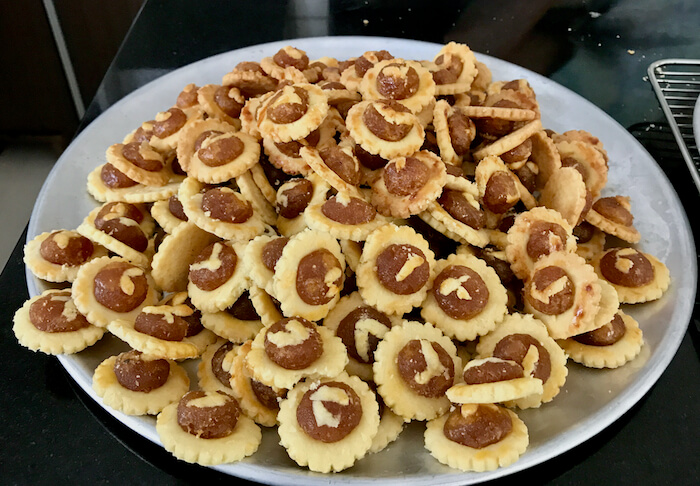
Preparing for Chinese New Year
There is much to be done before the New Year arrives. Houses are cleaned and decorated. New (traditionally red) clothes are purchased. Debts are paid to start the year with a clean slate.
Stores pop up full of decorations, biscuits, mandarin oranges and other delicacies.
Parents go to the bank to get crisp new notes to prepare for the Hong Bao (red packets). Rice bowls are filled—it’s considered bad luck to have an empty rice container in the house.
You will see Chinese New Year decorations everywhere—lanterns, replicas of zodiac animals and more—especially in Chinatown—beginning the month before New Year.
Many shop keepers set up seasonal market stalls outside their shops to take advantage of this hectic season, selling decorations with that year’s zodiac animal, paper red lanterns and traditional calligraphy with the words Fu (fortune), Lu (prosperity) and Shou (longevity). The atmosphere is very lively and people from all over come to shop, eat and drink until late into the night.
Pineapple Tarts, Love Letters, Almond Cookies, Kuih Bang Kit and More
Singaporeans go cookie mad before the holiday—buying and baking. They bring these canisters of cookies to all the people that they visit.
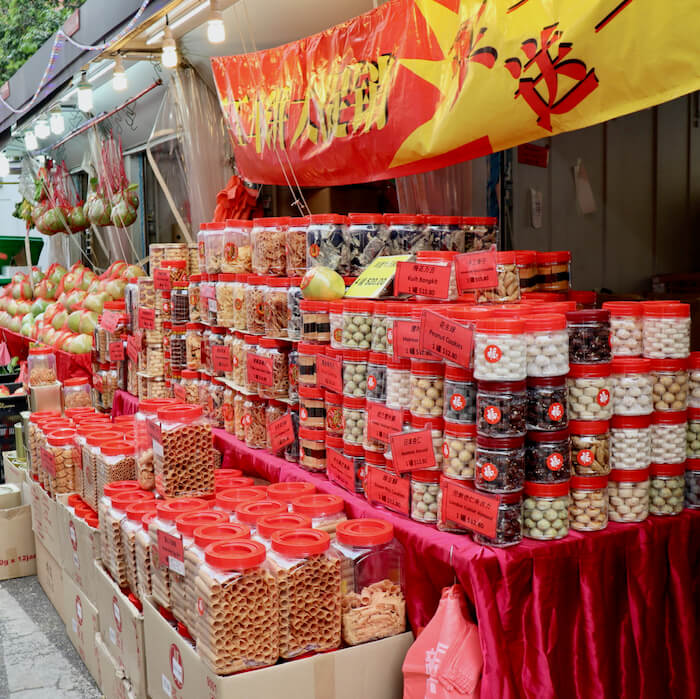
Pineapple tarts are very popular, and everyone has their own opinion on the best ones. The malls shopping areas will be full of vendors selling cookies. You can spend hours sampling cookies before you find the perfect one.
Some people still bake their own. We helped a friend and her mom bake 1000+ pineapple tarts last year.
Give a Pair of Mandarin Oranges
You’ll also see shops and supermarkets full of people lined up to buy dozens of mandarin oranges. Singaporeans take oranges everywhere they visit. They are a sign of good luck. Giving a pair of oranges is used to pay respect to elders.
What are those Red Packets (Hong Bao) that People Hand Out?
For children, Hong Bao is one of the most exciting things about Chinese New Year because they contain money. Usually, crisp new bills.
Children and or unmarried adults receive a red packet from their elders. Married couples hand out Hong Baos to their unmarried siblings or nephews and nieces.
How do I say Happy New Year?
In Cantonese: Kung Hei Fat Choi means I wish you earning more money this year
or
Sun Lin Fai Lok Happy New Year in Cantonese.
Try Your Luck in the Lottery
Chinese New Year is a great excuse for all types of gambling, including the very popular 4D lottery. Look for a long line, get on it and tell the cashier you want a quick pick bet. Don’t forget to check for the winning numbers after the day of the draw. You never know
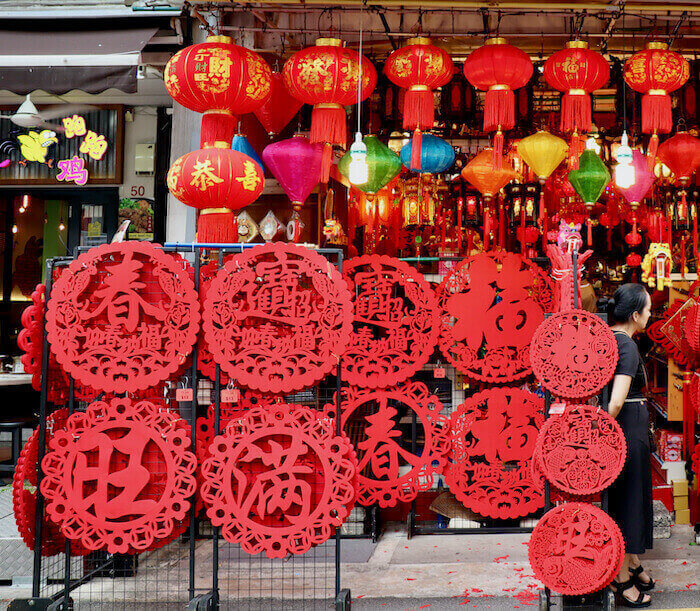
Visit Chinatown Before (And During) the New Year
It is especially fun to visit Chinatown days before Chinese New Year. Energy levels are high, shops are busy with customers getting ready for the new year celebrations. You will encounter colorful processions, performances, and lively revelry especially in the evenings. There are nightly performances on the stage near the Temple of the Buddha Relic. You will find yourself amidst the hustle and bustle of last-minute shoppers and locals buying goodies, biscuits, watermelon seeds, preserved meats, nuts, sweets, beverages, decorations, and other knick knacks.
Nearest MRT: Chinatown
What is Reunion Dinner?
For many families, Reunion dinner is one of the most important days of the year. Closest family attend and many people come home from overseas. The dinner has many courses – chicken, shrimp, mushroom, vegetables and soup. Nowadays, some families are keeping it simple and have steamboat dinner.
Chinese New Year Day
In Reggie’s family, Chinese New Year was a busy visiting day. Her parents each had lots of brothers and sisters.
We started by visiting my parents elder siblings – usually in the order of birth. Since both my parents were among the youngest, we set out very early to get all the visits in.
Visitation took the whole day. At every home, we greeted our uncles and aunties, were handed an ang pow (red packet) and then stuffed ourselves with Chinese New Year goodies and drank soda. Fanta Orange used to be served most as I recall.
The first two days followed in this manner and then it was time for the elder siblings to return the favor. My mother would make a huge pot of curry chicken or fry up some of her famous Mee-Siam (vermicelli noodles in a spicy tangy sauce). My relatives would flock to our apartment, usually round about lunch time!
Third Day of Chinese New Year
On the 3rd day, you may be lucky enough to catch lion and dragon dances especially at the businesses owned by Chinese proprietors. On our most recent visit, we chanced upon several lion dances – once at a restaurant and then around a few shopping malls. The performers in their lion head dresses and costumes danced to the rhythm of the pounding drum beats, bestowing prosperity on the business or household. They are then rewarded with a generous red packet!
Many families also take this opportunity to host parties and there’s plenty of food, drinks and even gambling going on. Again, this is one of the best times for people to reconnect with their relatives and to spend time together.
What is Lo Hei?
Lo Hei is a unique Singapore tradition.
During Lo Hei or Yu Sheng, a group of friends or family toss raw fish, salad and other fun ingredients like noodle crackers while chanting for good fortune and good health to be bestowed on the participants. The higher you toss, the greater the wealth (and also messier the table).
These days, it is possible to go from a lo hei in the afternoon to another one at dinner. When we were last in Singapore, almost every meal had the opportunity for us to toss for our fortune.
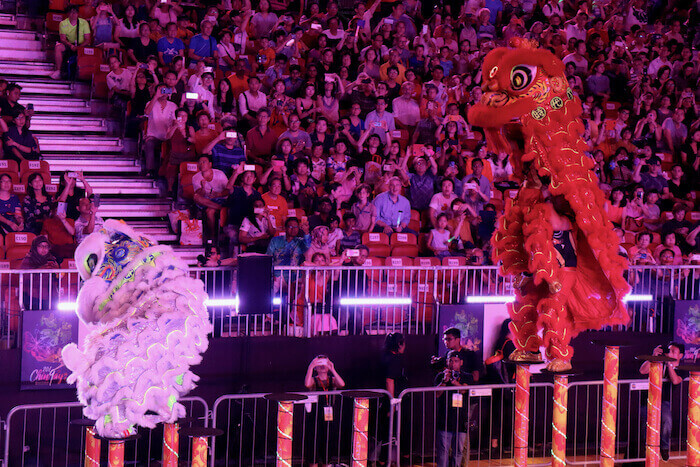
River Hongbao
Chinatown isn’t the only place for Chinese New Year action. Near Marina Bay Sands and waterfront, the River Hongbao at the Esplanade has Chinese New Year festivities.
You can take a bumboat cruise from either Clarke Quay to view the fireworks or go the MRT to Promenade. Makansutra is a good place for dinner before you wander over to the floating platform for the delicacies, performances and giant lanterns. This is a great place to bring kids as there are amusement rides, carnival games and plenty of photo-opportunities. There are fireworks on opening night of the River Hong Bao.
The Chingay Parade in Singapore
The Chingay Parade Singapore, an annual highlight, is a spectacular float and dance parade that marks a rousing end to Chinese New Year celebrations in the Singapore. It is the largest street performance in Asia with performers representing most of the Asian countries. The costumes, dances and floats are amazing.
It’s very hard to get tickets for Chingay. If you are lucky enough to score a ticket to the show, you are in for quite an evening.
Singaporean Insider Tip: There are viewing areas for the Chingay Parade next to the Singapore Flyer. You’ll have a good view of the floats and processions from that spot. We recommend arriving early.
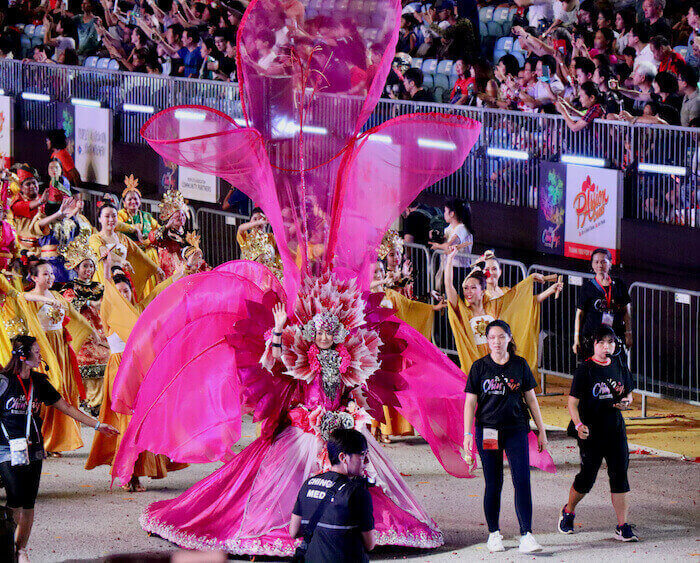
Thaipusam in Singapore is another unique religious ceremony to experience in Singapore.
Have you Celebrated the Chinese New Year in Asia? We’d Love to Hear From You.
Travel for Life Now is a participant in the Amazon Services LLC Associates Program, an affiliate advertising program designed to provide a means for sites to earn advertising fees by advertising and linking to amazon.com. Amazon and the Amazon logo are trademarks of Amazon.com, Inc. or its affiliates.
Please Pin and Share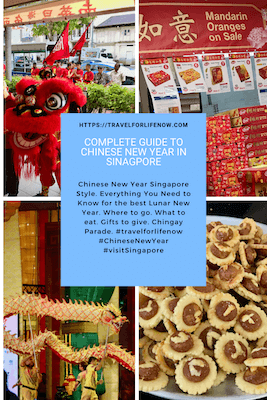
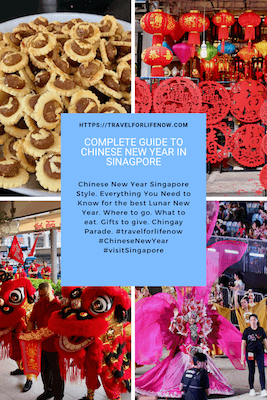
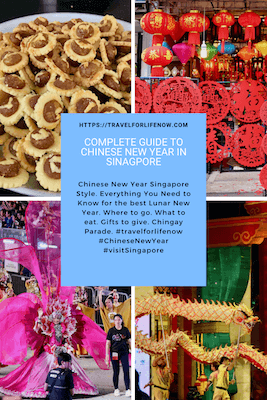

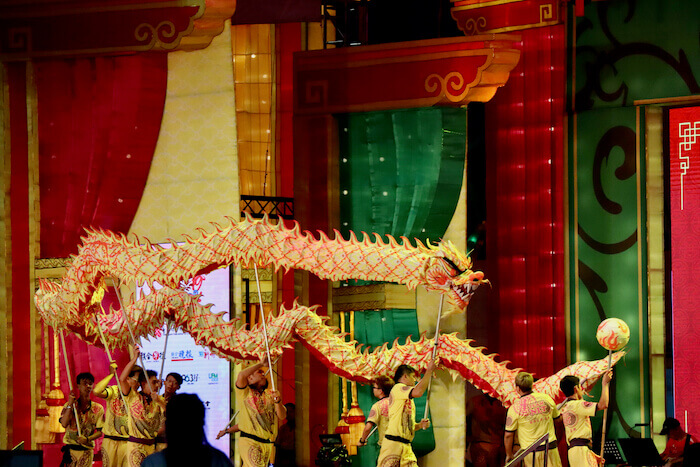
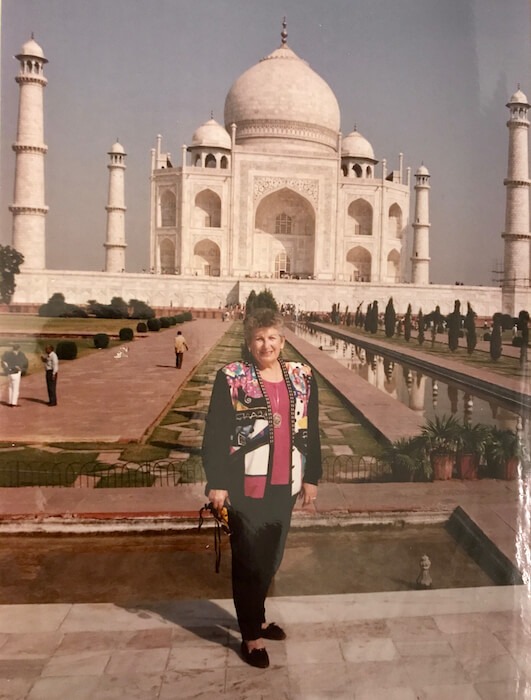
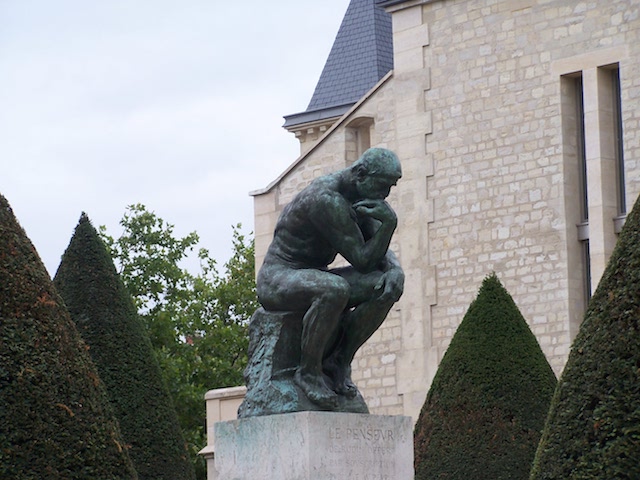
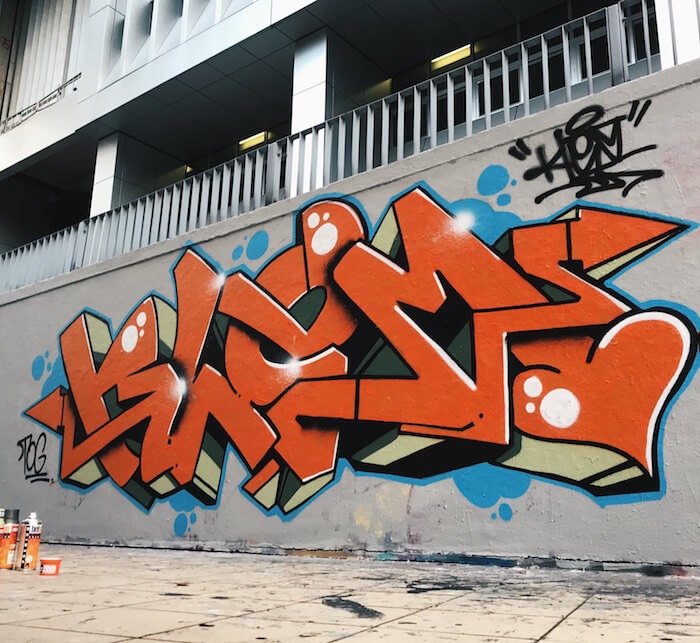
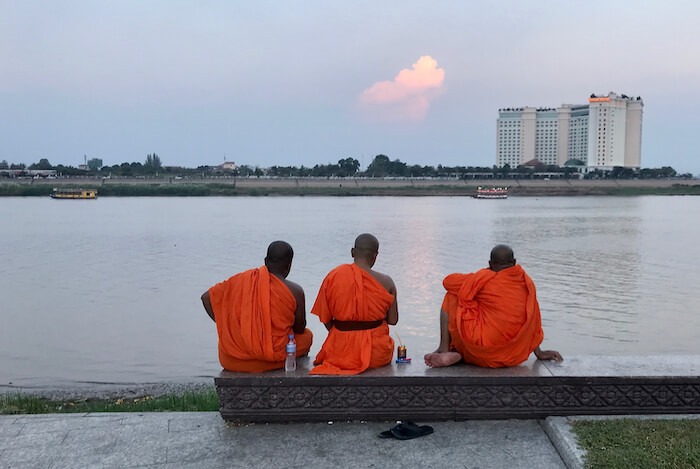
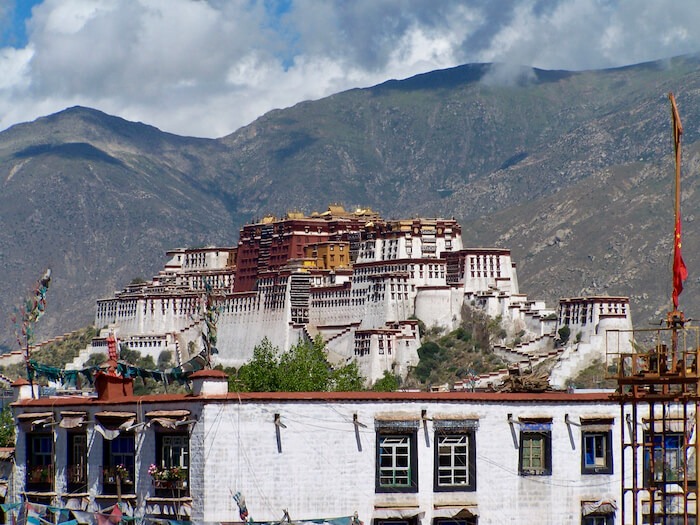
I love this post! As a Singaporean currently living abroad, you’ve made me missed such a vibrant time of year. The one thing I don’t miss is cleaning up the mess you make while tossing lo hei haha! Thank you so much for sharing!
Glad it brought back fond memories. Lo Hei can be quite messy!
What a cultural explosion of colour and tradition. I would love to see this festival. It will go on my ever expanding Bucket List. Thank you.
Karen,
Hope that you get there. There’s a lot to do in Singapore.
Sue
I have celebrated Chinese New Year once in NYC and loved it. I bet it would be amazing in Singapore though. It’s so interesting to read about all the traditions and activities that go on to celebrate. I’m sure foreigners are often really confused why people are buying so many mandarin oranges, haha!
Elizabeth,
I’ve done Chinese New Year in NYC, too (I live here). And that is a lot of fun. Definitely hope you get to Singapore for one.
Sue
Wow there is so much interesting info in this post! I was in Singapore last month but only for 3 days, I’d definitely like to go back and experience a bit more!
Helena,
Singapore has tons to do. There’s another post on my site with a complete list of things to do in Singapore. It’s a 4 Day Itinerary but has 50 places to go (much more than can be done in 4 days).
Sue
So cool! I have lived in Shanghai for 2 years and watched the Chinese travelling like crazy for that period of time. This year I went to Hong Kong for Chinese New Year myself. Such a special occasion!
Chinese New Year is always very colorful and vibrant and witnessing it in Singapore must be very beautiful. From the amazing Chingay Parade to the River Hongbao to the unique tradition of Lo Hei, Chinese New Year in Singapore really looks fun and beautiful event.
Really interesting how similar CNY can be all around the globe, there are some really strong traditions that just stay true to the culture no matter where you are in the world. 🙂